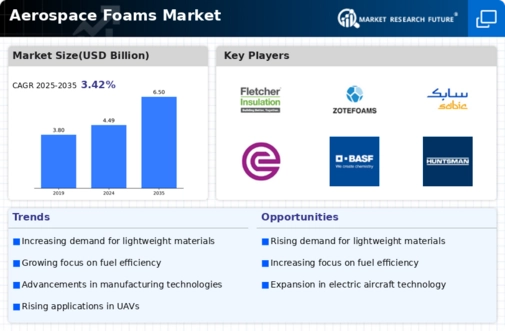Top Industry Leaders in the Aerospace Foams Market

High above the clouds, the aerospace foam market plays a vital role in crafting lighter, stronger aircraft, propelling the industry towards fuel efficiency and enhanced performance. But beneath the smooth aerodynamic surfaces lies a fiercely competitive landscape, where established players and agile innovators battle for market share.
Strategic Maneuvers Shaping the Market:
-
Industry Titans: Leading companies like Henkel, BASF, Huntsman Corporation, and Evonik leverage their extensive R&D capabilities, global reach, and established supply chains to maintain dominance. Their strategies focus on developing advanced foam solutions with customized properties, acquiring smaller players, and forming strategic partnerships with aircraft manufacturers. -
Regional Champions: Regional players like Mitsui Chemicals in Japan and Chomarat in Europe hold strong positions in their respective markets. They compete on price, cater to specific regional needs, and build strong local partnerships with airframe manufacturers. -
Niche Innovators: Smaller, technology-driven companies like Armacell and Airex carve niches with specialty foams like ultra-lightweight, fire-resistant, or bio-based solutions. They capitalize on unique capabilities and cater to specific aircraft categories, often at premium prices.
Factors Influencing Market Share:
-
Performance and Innovation: Offering a diverse range of high-performance foams with superior properties like density, thermal insulation, fire resistance, and acoustic dampening attracts diverse aircraft manufacturers and expands market share. Continuous innovation is crucial for staying ahead of the curve. -
Production Efficiency and Cost Optimization: Optimizing manufacturing processes, sourcing raw materials strategically, and offering competitive pricing are critical for gaining market share, particularly in cost-sensitive commercial aviation segments. -
Qualification and Regulatory Compliance: Meeting stringent aerospace regulations and undergoing rigorous qualification processes for specific aircraft applications are essential for market entry and growth. -
Sustainability and Environmental Impact: Developing eco-friendly foam solutions with recycled materials or bio-based alternatives addresses environmental concerns and opens doors to new markets. -
Customer Service and Technical Support: Providing excellent technical support, design engineering expertise, and close collaboration with aircraft manufacturers builds trust and repeat business.
Key Players:
-
BASF SE
-
Huntsman Corporation
-
ARMACELL
-
Boyd Corporation
-
Evonik Industries
-
Rogers Corporation
-
SABIC Innovative Plastics
-
General Plastics Manufacturing Company
-
Zetofoams Plc
-
ERG Materials
-
Aerospace Corporation
-
ERG Aerospace Corporation
-
Aerofoam Industries
-
Technifab Inc.
-
Mueller
-
Everchem Specialty Chemicals
-
UFP Technologies
-
Solvay
Recent Developments :
-
September 2023: BASF introduces a self-healing foam for aircraft seats, aiming to reduce maintenance costs and downtime. -
October 2023: Evonik acquires a startup specializing in 3D printing of customized foam components for complex aerospace applications. -
November 2023: A team of researchers at MIT develops a novel foam with tunable acoustic properties, offering potential for noise reduction in aircraft cabins. -
December 2023: Chomarat announces plans to expand its production capacity for bio-based foams, catering to the growing demand for sustainable solutions.

